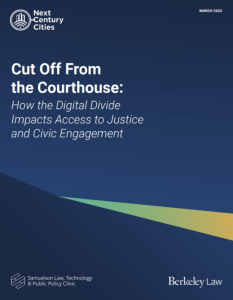By Corian Zacher

Following a year-long partnership, the Samuelson Law, Technology & Public Policy Clinic at the University of California, Berkeley, and Next Century Cities released Cut Off From the Courthouse: How the Digital Divide Impacts Access to Justice and Civic Engagement.
 The report features interviews with 27 professionals who have grappled with the transition to remote court and government proceedings, a practice made commonplace during the COVID pandemic. Even as social distancing restrictions are lifted, many aspects of virtual proceedings are here to stay.
The report features interviews with 27 professionals who have grappled with the transition to remote court and government proceedings, a practice made commonplace during the COVID pandemic. Even as social distancing restrictions are lifted, many aspects of virtual proceedings are here to stay.
Universities play an important role in developing innovative technological solutions and contributing unique research that is critical for crafting public policy. For example, long-term partnerships like OTO Fiber Corporation, a joint venture between the City of Old Town, the Town of Orono, and the University of Maine, bring high-quality infrastructure within reach for communities. A partnership between the Southwestern Pennsylvania Commission, Carnegie Mellon University, and Allies for Children, is taking a regional approach to understanding broadband needs and developing plans that spread beyond the borders of any single community.
 Meanwhile, states like Illinois are partnering with universities to improve broadband data gathering and house resources to help communities take advantage of upcoming funding opportunities. Research developed by Purdue University’s Center for Regional Development helps to inform the State of Indiana’s broadband strategies. Similarly, research on digital inequities from the Quello Center at Michigan State University has been a dispositive factor in the State of Michigan making closing the digital divide a priority statewide.
Meanwhile, states like Illinois are partnering with universities to improve broadband data gathering and house resources to help communities take advantage of upcoming funding opportunities. Research developed by Purdue University’s Center for Regional Development helps to inform the State of Indiana’s broadband strategies. Similarly, research on digital inequities from the Quello Center at Michigan State University has been a dispositive factor in the State of Michigan making closing the digital divide a priority statewide.
What does the report mean for broadband policy in your community?
- Prioritize access and adoption. Investments in affordable broadband service offerings, devices, and digital skills training help residents share their voice, apply for government services, and stay informed about local emergencies. NCC’s case studies explore a variety of initiatives in communities across the U.S.
- Partner with community organizations. Government partnerships with local organizations may help reduce trust barriers that prevent some households from enrolling in broadband affordability and access programs. Efforts in communities like Baltimore, Maryland, serve as important models for communities nationwide.
- Plug into existing relationships with people who need broadband. Public defenders, legal aid offices, and other legal service providers are potential ambassadors who can promote broadband adoption programs in low-income communities.

- Support enrollment in broadband subsidy programs. Local governments play an important role in ensuring that residents know about and have the support they need to enroll in affordable Internet programs. Learn more about how your community can support the Affordable Connectivity Program.
- Invest in local solutions. Communities across the country utilize a range of models to expand broadband access and improve adoption. NCC’s Becoming Broadband Ready Toolkit offers a guide for local leaders building momentum in their communities.
Additional Resources
- Read the Executive Summary Here
- Samuelson Clinic Report on Access to Broadband (Berkeley Blog)
- What’s new in digital equity? The digital divide and access to justice (GovTech)
- Digital Divide Means Justice Denied (MultiChannel News)
- 4 Steps to Successful City-University Partnerships (GovTech)
- Letter to FCC Staff Discussing the Ways that the Emergency Broadband Benefit could Support Innovative Municipal Solutions
